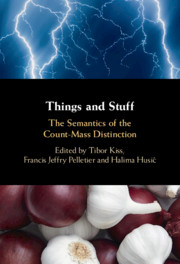Book contents
- Things and Stuff
- Things and Stuff
- Copyright page
- Dedication
- Contents
- Figures
- Tables
- Contributors and their Affiliations
- Preface
- 1 Editorial Introduction: Background to the Count–Mass Distinction
- Large-Scale Architectures for Count and Mass
- Implications from Individual Languages
- Compositional Analyses and Theoretical Issues
- New Empirical Approaches to the Semantics of the Count–Mass Distinction
- 14 The Role of Context and Cognition in Countability: A Psycholinguistic Account of Lexical Distributions
- 15 Plurality Without (Full) Countability: On Mass-Like Categories in Lexical Plurals
- 16 Determining Countability Classes
- 17 Polysemy and the Count–Mass Distinction: What Can We Derive from a Lexicon of Count and Mass Senses?
- References
- Language Index
- Subject Index
16 - Determining Countability Classes
from New Empirical Approaches to the Semantics of the Count–Mass Distinction
Published online by Cambridge University Press: 21 May 2021
- Things and Stuff
- Things and Stuff
- Copyright page
- Dedication
- Contents
- Figures
- Tables
- Contributors and their Affiliations
- Preface
- 1 Editorial Introduction: Background to the Count–Mass Distinction
- Large-Scale Architectures for Count and Mass
- Implications from Individual Languages
- Compositional Analyses and Theoretical Issues
- New Empirical Approaches to the Semantics of the Count–Mass Distinction
- 14 The Role of Context and Cognition in Countability: A Psycholinguistic Account of Lexical Distributions
- 15 Plurality Without (Full) Countability: On Mass-Like Categories in Lexical Plurals
- 16 Determining Countability Classes
- 17 Polysemy and the Count–Mass Distinction: What Can We Derive from a Lexicon of Count and Mass Senses?
- References
- Language Index
- Subject Index
Summary
This paper provides a corpus-driven investigation into establishing classes of nouns based on grammatical environments relevant to countability, such as combination with cardinal modifiers or appearing as a bare singular. We investigate the countability environments of Allan (1980) and assess their predictive power across a large corpus (350 million words). We show, by applying machine learning methods, that while the environments Allan (1980) distinguishes are predictive, the occurrence of nouns as bare singular and/or bare plural is substantially more powerful as a diagnostic. Using the most important environments, we induce, through automatic clustering, a set of countability classses, which distinguish between varieties of countable, non-countable and pluralia tantum nouns.
Keywords
Information
- Type
- Chapter
- Information
- Things and StuffThe Semantics of the Count-Mass Distinction, pp. 357 - 376Publisher: Cambridge University PressPrint publication year: 2021
Accessibility standard: Unknown
Why this information is here
This section outlines the accessibility features of this content - including support for screen readers, full keyboard navigation and high-contrast display options. This may not be relevant for you.Accessibility Information
- 3
- Cited by
